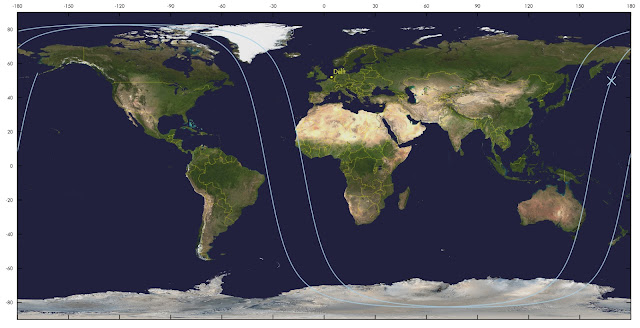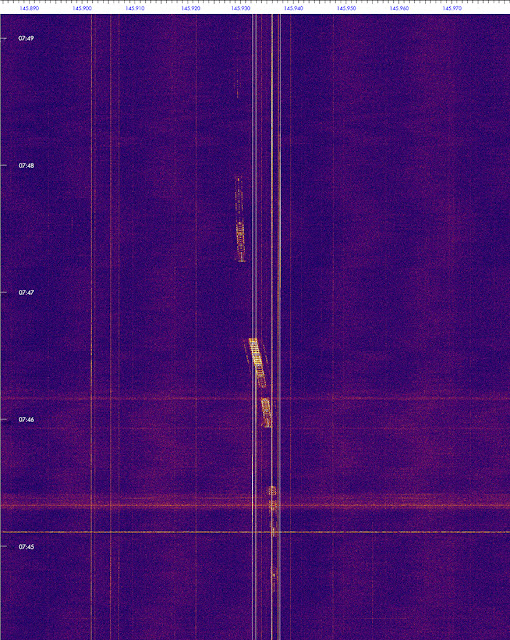[ Post last updated: 14 Nov 2023 12:45 UTC ]
In my October 25 blogpost I presented imagery of the iconic 3U cubesat Delfi-C3 (2008-021G) taken by my tracking camera. I also provided a reentry forecast in that post, that I updated several times.That reentry is currently (mid November 2023) very near.
I am now consolidating the reentry forecasts in this current, periodically updated blogpost.
While late October the reentry forecast was still shifting to a later date with each orbit update, that shift is now flattening out, but the forecast is still fluctuating.
A geomagnetic storm that caused aurora at
middle latitudes on Nov 5/6 has had a clear effect in speeding up
orbital decay (the 'dip' can be seen in the digrams below). Over the weekend 11-12 November, solar activity was more mild than forecast, making the reentry forecast slowly shift to a later time with each orbital update.
My current "aftercast", based on a mid-November 13 orbit modelled in GMAT, is reentry on 13 November 2023, nominally near 20:39h UTC +- 1.5 hours (please note the uncertainty interval!), i.e. between 19 - 22 UTC (and likely between 20 - 21 UTC)
A SatEvo/SatAna analysis results in a very similar, if slightly earlier, time (nominally 19:34 +- 1.5h UTC). I do not expect it survived to November 14.
The orbit determination on which these 'aftercasts' are based, is from about 3 orbital revolutions before the forecasted reentry moment. This orbit can be of bad quality, as in these final stages, orbit determination is tricky.
Here is how the reentry forecast has been developing so far (note the sudden downward developing trend due to the Nov 5/6 geomagnetic storm):
 |
| click diagrams to enlarge |
This is probably the last reentry forecast update (or rather "aftercast" by now), as I do not expect new orbital elements to be released between this update and the reentry
(Note: forecast data in tabular form are at the bottom of this post)
This is the Delfi-C3 ground-track over the current uncertainty interval (spanning two orbital revolutions) in the forecast:
 |
| click map to enlarge |
These reentry predictions are based on a tumbling satellite with, due to the tumbling, an average drag surface of about 60% of the maximum drag surface. Previous experience with modelling reentries in GMAT has shown this to be a reasonable value for a tumbling object.
What makes these reentry forecasts challenging, and creates the large uncertainties in the reentry position is a combination of things. One is the, even at short timescales, varying solar activity and it's influence on the upper atmosphere, which cannot be well predicted or captured by the model. Second, during the last orbits just before reentry, all kind of gas flow mechanisms around the spacecraft are taking place, which alter tyhe cdrag it expriences. Moreover, in this final stage where the spacecraft meets a more thicker resistance of the upper atmosphere, it sometimes auto-stabilises itself in a least-drag orientation, prolonging survival slightly. Last but not least: in the last moments of the spacecraft's life, when it is in a very low, fast changing orbit, orbit determination becomes difficult, affecting tehe quality of the last orbital elements available for the forecast.
I do not expect a TIP to be issued for this object. TLE updates might end a few hours before the actual reentry, after which CSpOC issues an 'administrative decay'.
Delfi-C3 's orbit had decayed to below 187 x 177 km by mid 13 Nov 2023, and the cubesat was coming down increasingly fast, as can be seen in the diagrams below (the orbit was dropping by almost 100 km/day mid 13 Nov 2023):
 |
| click diagrams to enlarge |
 |
| click diagram to enlarge |
Note that Delfi-C3 is very small and lightweight (2.2 kg and 30 x 10 x 10 cm) and the reentry will have been completely harmless. The friction with the molecules in the atmosphere will heat up the spacecraft during its final moments, untill it burns up completely, at altitudes above 50 km. The current ground-track where it can come down, is almost completely over Ocean.
The operators of Delfi-C3 have put out a call to radio amateurs to try to receive and decode telemetry from the cubesat. Software to decode is provided here. The goal is to try to follow Delfi-C3 and get telemetry as close to reentry as possible.
Note that Delfi-C3 only sends telemetry when it is in sunlight, and not continuously as after 15 years the system is showing issues. The frequency is 145.870 MHz, it is sending 1200 Bd BPSK packages. See also here.
[EDIT: as off 11 november, the cubesat seems to have shifted to a backup frequency near 145.934 MHz, as can be seen in this spectogram from my detection in the morning of November 11. The 145.870 MHz frequency is also still intermittently active. So pay attention to both frequencies]
 |
| click spectrogram to enlarge |
[end of edit]
On the morning of Nov 8, during the 7:43 UTC pass, I received thise radio signal of Delfi-C3 from Leiden, the Netherlands (but could not decode the signal), clearly a bit early on the then available TLE:
 |
| click image to enlarge |
The "stepped" effect is due to attempts to correct the Doppler shift. That Doppler shift (the "s"-shape in frequency due to the Doppler effect in the signal) can be very nicely seen in this spectogram from the same pass as received by my colleagues at Delft University of Technology (image courtesy Bart Root, TU Delft):
 |
| click image to enlarge. Image courtesy Bart Root, TU Delft |
Radio signals from the cubesat were also received by me and the TU Delft station on later dates, most recently in the morning of November 13th during the 7:24 UTC pass:
 |
| Nov 13 ~7:24 UTC radio spectrogram from Leiden. Click image to enlarge |
Delfi-C3 is a 3U cubesat developed and built at Delft Technical University in the Netherlands, and launched 15 years ago, in 2008.
More on Delfi-C3 on the website of Delft Technical University. There is also a nice background article on it's 15-year anniversary here.
The last (and only!) visual image of Delfi-C3 on-orbit, taken by me on 24 October 2023 from Leiden, the Netherlands, using a WATEC 902H2 Supreme and Samyang 2.0/135 mm lens at 25 fps (image is a frame-stack of 16 frames: the faint trail lower right is Delfi-C3 moving through the field of view. See also blogpost here which also features some video footage):
TABLE: Forecast development in tabular form (most recent one at bottom).
All dates and times are in UTC. Quoted times are nominal times, please take into account the uncertainty intervals that go with them!
orbit date orbit epoch reentry forecast + uncertainty
08 okt 2023 13:52 23281.57810544 05 nov 2023 02:23 ± 8.3 day
09 okt 2023 14:28 23282.60344413 05 nov 2023 08:17 ± 8.0 day
10 okt 2023 19:41 23283.82047902 05 nov 2023 11:00 ± 7.7 day
12 okt 2023 00:53 23285.03692402 05 nov 2023 20:20 ± 7.4 day
13 okt 2023 01:27 23286.06083878 06 nov 2023 18:43 ± 7.4 day
14 okt 2023 00:29 23287.02034889 06 nov 2023 18:53 ± 7.1 day
15 okt 2023 08:42 23288.36296159 07 nov 2023 00:59 ± 6.8 day
16 okt 2023 00:02 23289.00204702 07 nov 2023 04:44 ± 6.7 day
16 okt 2023 15:23 23289.64097529 08 nov 2023 02:01 ± 6.7 day
17 okt 2023 18:58 23290.79063916 08 nov 2023 12:14 ± 6.5 day
18 okt 2023 19:29 23291.81212343 08 nov 2023 21:43 ± 6.3 day
20 okt 2023 00:35 23293.02450124 09 nov 2023 16:03 ± 6.2 day
21 okt 2023 01:04 23294.04489630 09 nov 2023 19:49 ± 5.9 day
21 okt 2023 19:26 23294.80984121 09 nov 2023 22:19 ± 5.7 day
22 okt 2023 19:54 23295.82928392 09 nov 2023 23:43 ± 5.4 day
24 okt 2023 07:03 23297.29389307 10 nov 2023 23:54 ± 5.3 day
26 okt 2023 00:17 23299.01200402 11 nov 2023 11:29 ± 4.9 day
27 okt 2023 00:42 23300.02946319 11 nov 2023 12:23 ± 4.6 day
28 okt 2023 01:06 23301.04628230 11 nov 2023 16:02 ± 4.4 day
28 okt 2023 19:24 23301.80847586 11 nov 2023 18:46 ± 4.2 day
30 okt 2023 00:20 23303.01441157 12 nov 2023 09:54 ± 4.0 day
31 okt 2023 00:41 23304.02910990 12 nov 2023 13:04 ± 3.8 day
01 nov 2023 01:02 23305.04306068 12 nov 2023 17:28 ± 3.5 day
02 nov 2023 11:58 23306.49918974 12 nov 2023 17:44 ± 3.1 day
03 nov 2023 07:42 23307.32139835 12 nov 2023 23:36 ± 2.9 day
04 nov 2023 07:58 23308.33247480 12 nov 2023 19:20 ± 2.5 day
05 nov 2023 00:38 23309.02698061 12 nov 2023 21:03 ± 2.4 day
06 nov 2023 00:51 23310.03600547 12 nov 2023 05:15 ± 1.9 day
07 nov 2023 01:02 23311.04321962 12 nov 2023 09:23 ± 1.6 day
07 nov 2023 13:06 23311.54617034 12 nov 2023 14:38 ± 1.5 day
07 nov 2023 14:36 23311.60900895 12 nov 2023 14:25 ± 1.5 day
08 nov 2023 01:10 23312.04868443 12 nov 2023 15:48 ± 1.4 day
08 nov 2023 13:13 23312.55073768 12 nov 2023 19:28 ± 1.3 day
08 nov 2023 19:14 23312.80157938 12 nov 2023 20:14 ± 1.2 day
08 nov 2023 20:44 23312.86427030 12 nov 2023 20:32 ± 1.2 day
09 nov 2023 01:15 23313.05229412 12 nov 2023 21:16 ± 1.2 day
09 nov 2023 13:16 23313.55332040 12 nov 2023 20:49 ± 1.0 day
09 nov 2023 14:46 23313.61590941 12 nov 2023 20:54 ± 1.0 day
09 nov 2023 19:17 23313.80362555 12 nov 2023 21:54 ± 22.4 hr
10 nov 2023 01:17 23314.05377944 12 nov 2023 23:07 ± 20.9 hr
10 nov 2023 14:47 23314.61604116 13 nov 2023 01:14 ± 17.5 hr
10 nov 2023 20:46 23314.86565574 13 nov 2023 01:32 ± 15.8 hr
11 nov 2023 01:15 23315.05274319 13 nov 2023 02:37 ± 14.8 hr
11 nov 2023 13:13 23315.55109903 13 nov 2023 06:40 ± 12.4 hr
11 nov 2023 19:11 23315.79995400 13 nov 2023 08:42 ± 11.3 hr
12 nov 2023 01:09 23316.04856854 13 nov 2023 10:21 ± 10.0 hr
12 nov 2023 14:34 23316.60695182 13 nov 2023 14:53 ± 7.3 hr
13 nov 2023 00:57 23317.03998349 13 nov 2023 17:11 ± 4.9 hr
13 nov 2023 11:18 23317.47133062 13 nov 2023 19:55 ± 2.6 hr
13 nov 2023 12:47 23317.53274184 13 nov 2023 20:06 ± 2.2 hr
FINAL 'aftercast':
13 nov 2023 15:53 23317.65534723 13 nov 2023 20:39 ± 1.5 hr


No comments:
Post a Comment